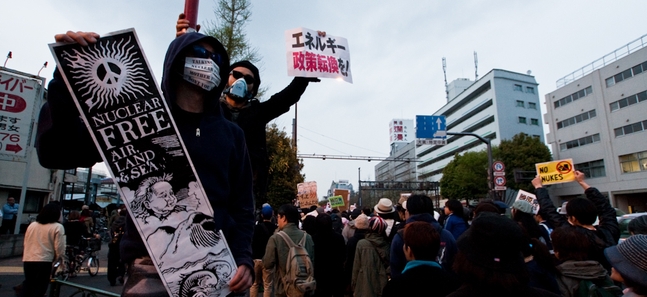Anti-nuclear march, Koenji, April 10
Time Out sees Japan's 'apathetic' youth take to the streets

Posted: Sun Apr 10 2011
As Hajime Matsumoto, organizer of today's demo, admitted last week, there was simply no way of knowing how the protest was likely to turn out. Japan's youth had long been considered too apathetic – too politically disinclined – to get worked up about anything, let alone take to the streets. Not that they lacked any precedent, of course. Students across the country united in vast numbers to march during the late '60s and early '70s, and there are anti-nuclear demonstrations in the capital every month, though the numbers are in the tens rather than the hundreds. While the figures for today have yet to be officially announced (the organizers are currently claiming 15,000; more conservative guestimates are around 5,000), one thing is certain: this was the biggest march Tokyo has seen in decades.
The vast crowd that descended on Koenji Chuo Park between 2-3pm represented a wide demographic. Largely young and Japanese, there were enough foreign faces to make it feel international, and the generation that marched 40 years ago was also well represented. Musicians, clowns, hippies and performance artists added extra dashes of colour to a crowd sporting hundreds of homemade placards – mostly calling for an end to nuclear power, though some took the chance to protest nuclear disarmament and one opportunist lambasted his singleton status, much to delight of the media that homed in on him.
If the messages on the banners were confused, the voices from the stage were almost unintelligible. A poor sound system meant that speeches by Matsumoto and his cohorts barely carried beyond the first few rows, though this did little to dampen the carnival atmosphere. As the sun lit up the gorgeous spring afternoon, musicians balanced on floats and led the crowds through the streets; veteran dancehall MC Rankin Taxi, providing the throng with sound bites ('Genpatsu, dame zettai! Genpatsu iranai!' - 'Nuclear power, absolutely not! Nuclear power, we don't need it!') that continued to echo throughout the afternoon.
For over three hours, the throng pressed on, helped along the way by the police – a good natured presence that did as much as it could to ensure the safety of the protestors. Never once, as far as Time Out could see, did the coppers behave in a heavy-handed fashion. On a couple of occasions we saw marchers attempt to antagonize them, but those around seemed more embarrassed by their comrades' behaviour than supportive, and the police adopted an 'if we ignore them, they'll stop it' attitude, as though they were dealing with errant children.
As evening came and the march wound up at Koenji Station, news began to break of the re-election of Governor Shintaro Ishihara, and the mood seemed to dip. It felt like a cold, hard slap in the face – a reminder that, as soon as the fun was over, life would continue unchanged.
And yet, it's unlikely that that will be the case. As Matsumoto told us last week, this is the first of a number of demos planned for the coming months, and many of those taking part today were doing so for the first time. It's a long shot, but it's possible that what we've just seen in the streets of Koenji was the beginnings of a newly radicalized Japan – a generation, finally, willing to stand up and call for change. Ishihara may find his fourth term less comfortable than he would've liked.
Tweets
- About Us |
- Work for Time Out |
- Send us info |
- Advertising |
- Mobile edition |
- Terms & Conditions |
- Privacy policy |
- Contact Us
Copyright © 2014 Time Out Tokyo














Add your comment